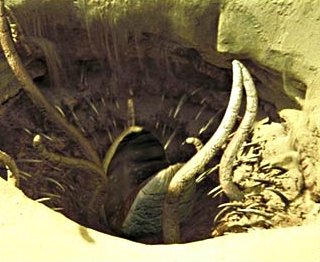The Sweetshrub
The story of Sweetshrub, why lobsters look like bugs, and how a flower behaves like a Sarlacc Pit.
Calycanthus floridus, ‘Venus’, June 22
“When life gives you lemons, order the lobster tail.”
Out of all the creatures we make into food, lobsters may be the strangest. Taxonomically speaking, a lobster is a marine crustacean of the family Homaridae, characterized by five pairs of jointed legs, an elongated muscular tail, and nocturnal hunting predilections. The name lobster derives from the Old English lopustre, thought to be a corruption of the latin word for locust (locusta) combined with the Old English loppe, or spider. It’s clear that for a very long time we have thought of lobsters much like giant sea bugs. As it happens, we weren’t that far off. In fact, all crustaceans belong to the phylum Arthropoda, the same as insects, arachnids, and millipedes, all of which share a chitinous segmented exoskeleton and lack of centralized brain-spine assembly.
We catch these outsized marine vermin by the millions (tens of millions, actually) every year for feasting purposes, to put aside steaks or with corn cobs during ritualistic summer jubilees. In 2021, Maine’s hardworking lobstermen (and a few lobsterwomen) hauled in a record 108 million pounds of lobster. That is a lot of lobster. For reference, a 500 ft long Akula-class Russian submarine, by all accounts the heaviest submarine ever built, weighs approximately 96 million pounds. As much as that is, and as many Mainers are keen to relate, the North American lobster, Homarus americanus, historically bred so prodigiously along New Englands coastline that they were fed to prisoners and ground up as fertilizer. Servants sought written agreements for employment that stipulated they be served lobster no more than twice per week. It was “like making people eat rats”, according to David Foster Wallace. Then, miraculously, and unfortunately from the lobster’s perspective, someone thought to cover them with butter and serve them to rich people: they were pronounced delicious, gradually grew scarce, and so became synonymous with luxury and fine dining.
To catch a lobster, one would typically employ a trap, or “pot”, as the contraption is sometimes confusingly referred. The bait, often dead herring, is placed in the ‘kitchen,’ a lure to coax the crustacean through a one way network of netting. Eventually the prey flees into the ‘parlor’, but it’s of no use. The trap is configured to baffle and entangle—betraying the lobster’s awkward arrangement of tail and claws. This method of trapping has been in use for over 200 years and is so simple and devastatingly efficient that its design has scarcely been improved upon in all the decades since.
German sweetshrub stamp
But long before we had engineered this quintessential crustacean catching apparatus, a palm-sized eggplant-tinted blossom native to North America had been ensnaring Arthropda, using much the same strategy, for eons.
Calycanthus floridus is a hearty broad leafed woody perennial, often called Sweet Shrub or Carolina Allspice, cultivated for its aromatic bark and agreeably scented blossoms. It tends to be planted in hedges or, as in my garden, as specimen plants. It grows contentedly in varying degrees of sunlight, and tolerates a diverse range of soil types. Calycanthus can be robust, growing up to 9ft tall and almost as wide. It is known to release aromatics when their leaves are bruised, much like Pelargonium, and produce indehiscent fruits (we learned about dehiscent fruits here). The English naturalist Mark Catesby was a fan and described it in his The Natural History of Carolina, Florida and the Bahama Islands (1731) as growing in "remote and hilly parts" and having bark "as odoriferous as cinnamon”. The leaves are deep green and leathery, intended to deter herbivores, but provide the happy unintended benefit of giving temperate gardens a tropical feel. The colonial planters of the Carolinas, Catesby reports, gladly transplanted it into their gardens.
There are currently 4 accepted species of Calycanthus: chinensis, occidentalis, brockianus, and floridus. The indigenous peoples of California used C. occidentalis in basketweaving and for arrow shafts, while the Cherokee applied bark ooze of C. floridus as a dermatologic aid to temper hives, improve eyesight, and, when needed, induce vomiting.
The flowers of the sweetshrub are like nothing else in the garden—delicate and complex with petals that reach and curl inward like the maw of an Arrakian sand worm. To be wholly accurate, they aren’t truly petals, but rather an archaic blend of sepals and petals called tepals, like those of the ancient Magnolias (discussed here). You may recall that plants of this relic age evolved blooms that attracted beetles rather than bees and so employed intrinsically distinct strategies.
A CGI Sarlacc
A garden Sarlacc
Witness the botanical lobster trap. Sweetshrubs seduce pollinators with fragrance (rather than bright colors) and so succeed as well in shade as they do in bright light, as do traps on ocean bottoms. Tucked deep within the flower, like the ‘kitchen’ of a lobster pot, are food bodies. These are unique cellular adaptations that sprout from the stamen and entice the beetles pollen-ward. The whorled vortex of tepals are arranged like tire spikes at a Hertz rental car lot, fostering ready entry and encumbering quick escape. The pollinator is drawn ever inward toward the bait. While this one way system of chambers and bribes echos the lobster trap, graciously (and by necessity), Calycanthus is more forbearing. After cross pollination is complete, the inner parts of the flower fold mercifully away, allowing egress, and starting the cycle anew.
Calycanthus floridus, ‘Hartlage Wine’, May 22
Knowledge Sources
Ultrastructural development of the beetle food tissue of calycanthus flowers Fred R. Rickson, 31 Dec 1978-American Journal of Botany (John Wiley & Sons, Ltd)-Vol. 66, Iss: 1, pp 80-86
https://www.columbia.edu/~col8/lobsterarticle.pdf
https://www.newworldencyclopedia.org/entry/Lobster
https://www.britannica.com/animal/lobster
https://247wallst.com/special-report/2018/05/11/the-heaviest-objects-in-the-world/
http://naeb.brit.org/uses/search/?string=Calycanthus+floridus
https://gnps.org/plant/sweetshrub-calycanthus-floridus/
https://www.britannica.com/plant/sweet-shrub
https://www.mainelobsternow.com/blog/how-does-a-lobster-trap-work
https://www.missouribotanicalgarden.org/PlantFinder/PlantFinderDetails.aspx?taxonid=278791
https://en.wikipedia.org/wiki/Calycanthus
https://www.onlineflowergarden.com/2020/09/19/gardening/shrubs/calycanthus-aphrodite/
http://www.gourmet.com.s3-website-us-east-1.amazonaws.com/magazine/2000s/2004/08/consider_the_lobster.html
At Home: A Short History of Private Life. Bill Bryson 2010
Image Sources
https://commons.wikimedia.org/wiki/File:Lobster_trap_in_Norra_Grundsund_1.jpg
https://commons.wikimedia.org/wiki/File:Calycanthus_floridus_var._glaucus_2019-05-19_04.jpg






